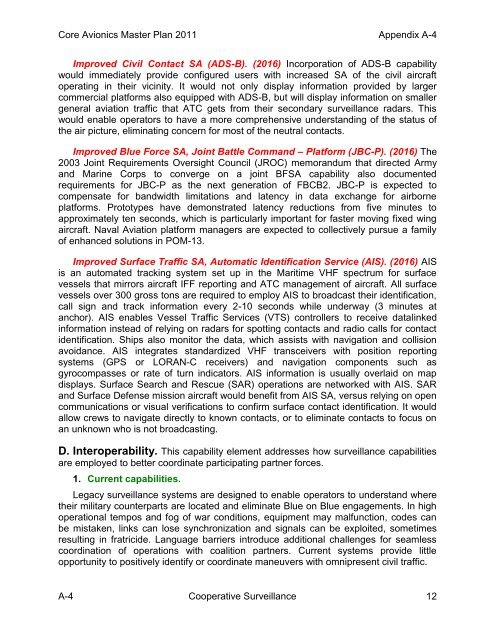Core Avionics Master Plan - NAVAIR - U.S. Navy
Core Avionics Master Plan - NAVAIR - U.S. Navy
Core Avionics Master Plan - NAVAIR - U.S. Navy
- No tags were found...
Create successful ePaper yourself
Turn your PDF publications into a flip-book with our unique Google optimized e-Paper software.
<strong>Core</strong> <strong>Avionics</strong> <strong>Master</strong> <strong>Plan</strong> 2011 Appendix A-4Improved Civil Contact SA (ADS-B). (2016) Incorporation of ADS-B capabilitywould immediately provide configured users with increased SA of the civil aircraftoperating in their vicinity. It would not only display information provided by largercommercial platforms also equipped with ADS-B, but will display information on smallergeneral aviation traffic that ATC gets from their secondary surveillance radars. Thiswould enable operators to have a more comprehensive understanding of the status ofthe air picture, eliminating concern for most of the neutral contacts.Improved Blue Force SA, Joint Battle Command – Platform (JBC-P). (2016) The2003 Joint Requirements Oversight Council (JROC) memorandum that directed Armyand Marine Corps to converge on a joint BFSA capability also documentedrequirements for JBC-P as the next generation of FBCB2. JBC-P is expected tocompensate for bandwidth limitations and latency in data exchange for airborneplatforms. Prototypes have demonstrated latency reductions from five minutes toapproximately ten seconds, which is particularly important for faster moving fixed wingaircraft. Naval Aviation platform managers are expected to collectively pursue a familyof enhanced solutions in POM-13.Improved Surface Traffic SA, Automatic Identification Service (AIS). (2016) AISis an automated tracking system set up in the Maritime VHF spectrum for surfacevessels that mirrors aircraft IFF reporting and ATC management of aircraft. All surfacevessels over 300 gross tons are required to employ AIS to broadcast their identification,call sign and track information every 2-10 seconds while underway (3 minutes atanchor). AIS enables Vessel Traffic Services (VTS) controllers to receive datalinkedinformation instead of relying on radars for spotting contacts and radio calls for contactidentification. Ships also monitor the data, which assists with navigation and collisionavoidance. AIS integrates standardized VHF transceivers with position reportingsystems (GPS or LORAN-C receivers) and navigation components such asgyrocompasses or rate of turn indicators. AIS information is usually overlaid on mapdisplays. Surface Search and Rescue (SAR) operations are networked with AIS. SARand Surface Defense mission aircraft would benefit from AIS SA, versus relying on opencommunications or visual verifications to confirm surface contact identification. It wouldallow crews to navigate directly to known contacts, or to eliminate contacts to focus onan unknown who is not broadcasting.D. Interoperability. This capability element addresses how surveillance capabilitiesare employed to better coordinate participating partner forces.1. Current capabilities.Legacy surveillance systems are designed to enable operators to understand wheretheir military counterparts are located and eliminate Blue on Blue engagements. In highoperational tempos and fog of war conditions, equipment may malfunction, codes canbe mistaken, links can lose synchronization and signals can be exploited, sometimesresulting in fratricide. Language barriers introduce additional challenges for seamlesscoordination of operations with coalition partners. Current systems provide littleopportunity to positively identify or coordinate maneuvers with omnipresent civil traffic.A-4 Cooperative Surveillance 12
















